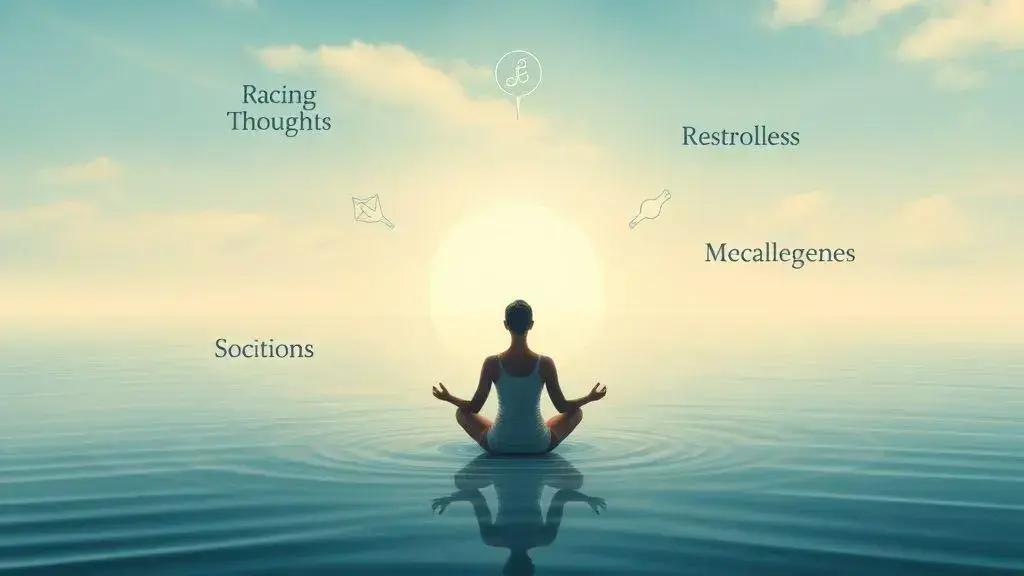Breathing meditation to calm the mind effectively

Breathing meditation is a mindfulness practice that focuses on controlling your breath to reduce stress and calm the mind, enhancing mental clarity and relaxation.
Breathing meditation to calm the mind is more than just a trend; it’s a practice that many find invaluable for enhancing their daily lives. Have you ever felt overwhelmed? Exploring this technique could be your path to tranquility.
Understanding breathing meditation
Understanding breathing meditation is essential for anyone looking to calm their mind and enhance their well-being. This practice centers around controlling your breath, which can lead to deeper relaxation and improved focus. It’s a simple yet powerful technique.
What is Breathing Meditation?
At its core, breathing meditation is about paying attention to your breath. By focusing on your inhalations and exhalations, you can anchor your mind, reducing distractions. This mindful awareness helps you connect with the present moment.
Benefits of Breathing Meditation
Engaging in breathing meditation offers numerous benefits:
- Enhances mental clarity
- Reduces stress and anxiety
- Improves emotional balance
- Increases overall mindfulness
These benefits contribute greatly to a serene state of mind. When you practice focusing on your breath, it helps you let go of worries and cultivate a sense of peace.
Many people find it helpful to create a designated space for their practice. This can be anywhere quiet and comfortable. Consider setting the mood with soft lighting or calming scents, as these elements can enhance your meditation experience.
How to Begin
To start, find a comfortable position, either sitting or lying down. Gently close your eyes and take a deep breath in through your nose. Feel your abdomen rise. Then, slowly exhale through your mouth, allowing your body to relax with each breath. Repeat this process, gradually finding your rhythm.
As you continue, you may notice your mind wandering. This is perfectly normal. When it happens, simply acknowledge the thought, then bring your focus back to your breath. Over time, you’ll find it easier to stay present and centered.
In summary, breathing meditation is a valuable practice that invites calmness and clarity into your life. With consistent practice, it can transform your daily experiences, allowing you to respond rather than react.
The science behind calming the mind

The science behind calming the mind reveals fascinating insights into how our brains function. Understanding this can help you appreciate the benefits of practices like breathing meditation. Neuroscience shows that focusing on your breath influences your body’s stress response.
The Brain and Stress Responses
When stress arises, the body triggers the fight or flight response. This causes an increase in heart rate and adrenaline levels. However, through techniques such as breathing meditation, you can activate the parasympathetic nervous system.
- Reduces cortisol levels
- Slows the heart rate
- Encourages feelings of safety
- Promotes relaxation
As you breathe deeply, this physiological shift signals your body to calm down. Studies show that regular practice helps reshape how the brain processes stress, leading to improved emotional regulation.
Furthermore, mindfulness practices help to create new neural pathways. This means that the more you meditate, the more trained your brain becomes to handle stress effectively. Engaging in breathing meditation fosters a greater awareness of your thoughts and emotions, allowing you to respond rather than react.
The Role of Conscious Breathing
Conscious breathing is another factor that supports mental calming. It encourages a deeper connection between mind and body. With every deep breath, you are signaling your brain to release tension. This distinction between shallow and deep breathing significantly impacts your mental state.
Deep breathing increases the flow of oxygen to the brain, which can enhance cognitive function. Moreover, it reduces feelings of anxiety by promoting a sense of control over your thoughts and feelings. By fostering relaxation and clarity, your ability to focus improves as well.
In summary, the connection between breath and mind is scientifically supported. Understanding how to manipulate your breathing patterns can lead to calming your mind and enhancing overall well-being.
Step-by-step guide to practicing breathing meditation
Practicing breathing meditation can be an effective way to find calmness and clarity in your day-to-day life. Here’s a simple, step-by-step guide to help you get started.
Step 1: Find a Quiet Space
Choose a quiet and comfortable spot where you won’t be disturbed. It can be indoors or outdoors, as long as it feels peaceful. Your environment is important in creating the right atmosphere for your meditation.
Step 2: Get Comfortable
Take a moment to sit or lie down in a comfortable position. You can sit cross-legged on the floor, on a chair, or lie flat. Just make sure your body feels relaxed and aligned.
Step 3: Focus on Your Breath
Close your eyes and start to pay attention to your breath. Inhale deeply through your nose, filling your lungs completely. Then, gently exhale through your mouth. Feel the rise and fall of your chest as you breathe. This focus on your breath helps anchor your mind.
Step 4: Notice Your Thoughts
As you meditate, thoughts may wander into your mind. It’s normal! Instead of engaging with those thoughts, simply recognize them. Acknowledge them, then gently bring your focus back to your breathing. This practice helps improve your awareness.
- When your mind drifts, gently return your attention to your breath.
- Try to practice for 5 to 10 minutes daily to start.
- Use a timer to help you keep track of your meditation time.
- Be patient; it takes time to develop your meditation skills.
As you continue practicing breathing meditation, you’ll notice improvements in your ability to concentrate and a decrease in feelings of stress. Gradually, you can extend your meditation sessions as you become more comfortable with the practice.
Step 5: End Your Session
After your meditation time, take a moment to open your eyes slowly. Sit for a moment before getting up. Notice how you feel. Take this newfound calmness into your day, and remember you can return to this practice anytime you need to relax.
Common challenges and how to overcome them

Practicing breathing meditation can come with its own set of challenges. Understanding these common hurdles can make the practice easier and more effective. Here are some frequent obstacles and ways to overcome them.
Difficulty Concentrating
Many people find it hard to focus while meditating. Distractions can interfere with your practice. To help with this:
- Start with short sessions to build your concentration.
- Use guided meditations that provide direction.
- Practice in a quiet environment free from interruptions.
As you develop your skills, you’ll notice improvements in your ability to concentrate.
Restlessness or Discomfort
Physical restlessness can arise during meditation, causing discomfort. If you experience this, try adjusting your posture or movement. Here are some tips:
- Change positions if you feel uncomfortable.
- Stretch lightly before starting your session.
- Ensure your space is comfortable and inviting.
These adjustments can help create a more pleasant experience.
Racing Thoughts
It is common for thoughts to rush into your mind during meditation. If this happens:
- Gently acknowledge the thoughts without judgment.
- Bring your focus back to your breath whenever distractions arise.
- Practice daily to help reduce the frequency of racing thoughts.
With time, this practice will help you return to a state of calm more easily.
Expectations of Outcomes
Having high expectations from your meditation can lead to frustration. Instead, approach meditation with an open mind. Recognize that each session is a step in your journey. Focus on the process instead of the outcomes. Remember that the benefits of breathing meditation take time to develop and vary from day to day.
By understanding these common challenges and employing simple strategies, your meditation practice can become more fulfilling and beneficial. Embrace the journey and be patient with yourself.
FAQ – Frequently Asked Questions about Breathing Meditation
What is breathing meditation?
Breathing meditation is a mindfulness practice focused on controlling and being aware of your breath, helping to calm the mind and reduce stress.
How long should I meditate each day?
Start with 5 to 10 minutes daily, and you can gradually increase the time as you become more comfortable with the practice.
What if I have trouble focusing during meditation?
It’s common to struggle with focus. Acknowledge your thoughts and gently return your attention to your breath. Consistent practice will help improve your concentration.
Can breathing meditation really reduce stress?
Yes, numerous studies show that breathing meditation can effectively lower stress levels by activating the body’s relaxation response.





